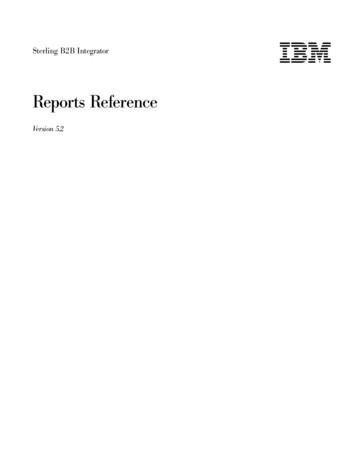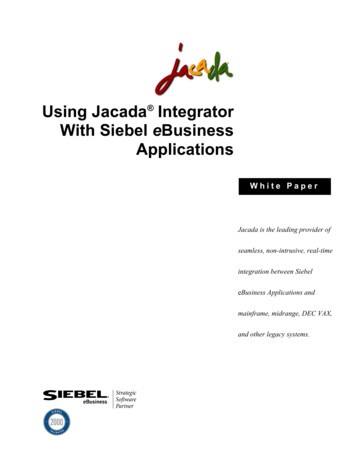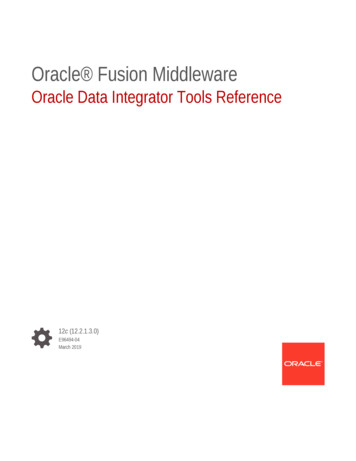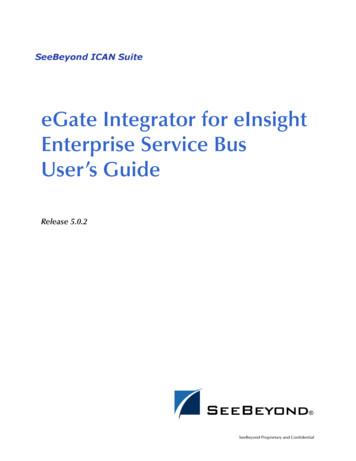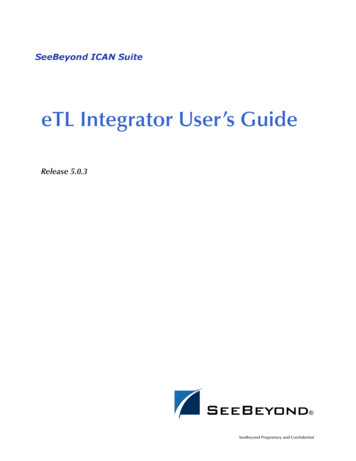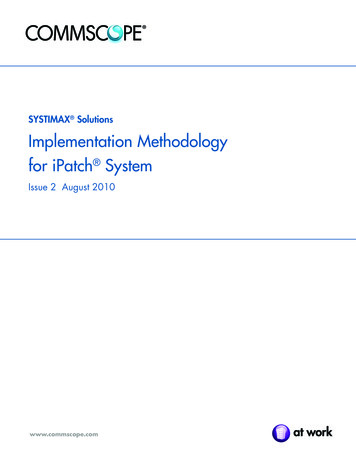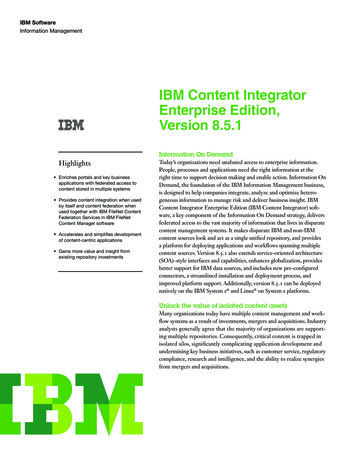
Transcription
IBM SoftwareInformation ManagementIBM Content IntegratorEnterprise Edition,Version 8.5.1Information On DemandHighlights Enriches portals and key businessapplications with federated access tocontent stored in multiple systems Provides content integration when usedby itself and content federation whenused together with IBM FileNet ContentFederation Services in IBM FileNetContent Manager software Accelerates and simplifies developmentof content-centric applications Gains more value and insight fromexisting repository investmentsToday’s organizations need unabated access to enterprise information.People, processes and applications need the right information at theright time to support decision making and enable action. Information OnDemand, the foundation of the IBM Information Management business,is designed to help companies integrate, analyze and optimize heterogeneous information to manage risk and deliver business insight. IBMContent Integrator Enterprise Edition (IBM Content Integrator) software, a key component of the Information On Demand strategy, deliversfederated access to the vast majority of information that lives in disparatecontent management systems. It makes disparate IBM and non-IBMcontent sources look and act as a single unified repository, and providesa platform for deploying applications and workflows spanning multiplecontent sources. Version 8.5.1 also extends service-oriented architecture(SOA)–style interfaces and capabilities, enhances globalization, providesbetter support for IBM data sources, and includes new pre-configuredconnectors, a streamlined installation and deployment process, andimproved platform support. Additionally, version 8.5.1 can be deployednatively on the IBM System z and Linux on System z platforms.Unlock the value of isolated content assetsMany organizations today have multiple content management and workflow systems as a result of investments, mergers and acquisitions. Industryanalysts generally agree that the majority of organizations are supporting multiple repositories. Consequently, critical content is trapped inisolated silos, significantly complicating application development andundermining key business initiatives, such as customer service, regulatorycompliance, research and intelligence, and the ability to realize synergiesfrom mergers and acquisitions.
IBM SoftwareInformation ManagementCustomerserviceMarketingCall centerImaging documentmanagementFinanceSales andsupportCRM/ERPReport managementCustomers andpartnersSelf-serviceWeb content/mediaasset managementDatabase customsystemsLegalComplianceNetwork file systemsHumanresourcesResearchdevelopmentWeb sitesWorkflow businessprocess managementFigure 1: Point-to-point integrations increase the complexity of ECM operations, adding significant ongoing costs and decreasing organizations’ abilities tomanage changes to the business environment.Too often organizations rely on homegrown point-to-pointintegrations to gain access to valuable content. These integrations exponentially increase the complexity, risk and cost of anenterprise content management (ECM) operation, since theyrequire staff to maintain knowledge of each separate contentsystem. Plus, any change to any of the systems can break theintegration along with any processes built on it. Organizations need the ability to manage content integration centrallyand consistently so they can adapt quickly and effectively tochanges in their operating environment.IBM Content Integrator software enables organizationsto quickly unify these content silos to improve access, reuseand control of distributed content assets, and to reducethe cost and complexity associated with creating contentcentric applications.By providing a consistent, bidirectional interface to disparatecontent sources, Content Integrator software enables organizations to quickly integrate their business applications withthe various content repositories that store documents, images,reports, digital assets, e-mail and other important businesscontent. This allows users to access and work with distributedcontent as if it were stored and managed in a single repositoryand “future-proofs” applications by providing a flexible, highlyscalable abstraction layer that supports repository-independentapplications. By simplifying repository integration and changemanagement, Content Integrator software can help organizations yield a measurable reduction in the costs and risks ofECM operation.
A proven, enterprise-class approach tocontent integrationBased on an SOA, IBM Content Integrator software providesrich, standards-based access to disparate content repositoriesand workflow systems. IBM Content Integrator softwareis fully compliant with Java Platform, Enterprise Edition(J2EE) technology, compatible with Web services and basedon three service layers.Facilitates SOA deployment and awarenessIBM Content Integrator software is SOA compliant and providesa published Web Services Description Language (WSDL),allowing other SOA-aware applications to communicate andinteract with each other. Its new application programminginterfaces (APIs) are stateless with high grain functionality forquery, export and transform functions. Content Integrator,Version 8.5.1 software further extends these services with document and folder creation, update and delete capabilities. Thesecapabilities ensure that content integration can be an essentialpart of SOA initiatives.Supports the IBM z/OS platform and Linux on z/OSContent Integrator, Version 8.5.1 software introduces full support for IBM z/OS operating system deployment, native onthe z/OS platform and through Linux on the z/OS platform.Content Integrator software now can be deployed directly withIBM Content Manager and Content Manager OnDemandsoftware on the z/OS platform, reducing network and conversion overhead for better processing performance in z/OSoperating environments.Content Integrator, Version 8.5.1 also provides native deployment on Linux on the z/OS platform for organizations thatneed to consolidate server farms and take full advantage ofthe economic efficiencies of IBM System z hardware without requiring their IT staff to have knowledge of the z/OSoperating system to manage the applications. Both optionsallow connectors to run on distributed platforms (includingthe Microsoft Windows and UNIX platforms) to providegreater flexibility in deployment and operation.Delivers robust integration servicesIBM Content Integrator integration services provide bidirectional access to the underlying information and functionalityof content and workflow systems. IBM offers a library ofprebuilt connectors to many commercial systems and a toolkitfor building custom connectors. These connectors normalizethe vendor-specific API calls of underlying repositories andprovide real-time, bidirectional access to the native content,processes and metadata stored in these systems.IBM Content Integrator software does not replicate content.It provides real-time access to content in place, allowing therepository to continue to service existing applications.Integration services expose all of the basic library services andthe specialized functionality of underlying repositories, andprovide repository profiling capabilities that make differences in functionality between repositories seamless to theend user. Integration services allow users to: Create, delete and browse folders.Check in, check out and modify content.Add new content.File and unfile content in folders.Retrieve folders and folder contents.View and update metadata.View and update security.View and create versions.Revert to previous versions.Work with renditions and compound documents.View active workflow items across workflow queues.Suspend, resume and complete workflow items.Create new workflow items.
IBM SoftwareInformation ManagementProvides federation services that supportnumerous capabilitiesWhen IBM Content Integrator software is used in conjunctionwith the Content Federation Services feature in IBM FileNet Content Manager 4.5 software, metadata from disparate repositories is federated into the IBM FileNet P8 content engine.There it appears as native FileNet P8 content and becomesavailable to FileNet P8 applications providing search andretrieval, records management and business process management (BPM) capabilities. Content views allow organizations to create a single logicalview of content related to a specific process or topic—regardless of where the content is stored and managed. Thesecontent views remove barriers imposed by disparate contentsources and make content appear as if it were organized in avirtual repository. Federated search capabilities enable property-based andfull-text queries against multiple repositories, returning anaggregated result set. This feature also allows users to createsaved searches for enhanced productivity. Metadata mapping services normalize index values acrossmultiple systems. This makes it easier to define a commondata model for working with content stored in multipledisparate repositories. Single sign-on capabilities encrypt and store repositorycredentials, allowing users to log in to multiple underlyingsystems through a single authentication process. Thiscapability can also integrate with existing LightweightDirectory Access Protocol (LDAP) infrastructures. Identity-aware repository session pools can be easilyconfigured within the administration tool and can be used toimprove application performance by reducing the number ofrepository log-ins and log-outs, and to manage the use ofrepository resources by limiting repository connectionsduring peak activity. Optional view services enable organizations to convertspecialized document and image formats into browserreadable renditions on the fly. View services can convert morethan 150 document types into browser-readable formats sothey can be displayed natively within a browser, includingstandard business formats and specialized formats such astagged image file format (TIFF) and Mixed Object:DocumentContent Architecture (MOD:CA). View services also provide asigned Java applet for annotations, printing and client-sideimage manipulation. Because Content Integrator softwareisolates client functions from its APIs, clients can call federatedcontent and render it on the fly.
CustomerserviceMarketingCall centerFinanceSales andsupportCRM/ERPCustomers esResearchdevelopmentWeb sitesIBM contentImaging documentmanagementReport managementWeb content/mediaasset managementDatabase customsystemsNetwork file systemsWorkflow businessprocess managementFigure 2: IBM Content Integrator software enables organizations to federate multiple, disparate content repositories and workflow systems.Includes developer servicesIBM Content Integrator developer services provide severaloptions for making distributed content and processes, as wellas the functionality around the content and processes accessible within user interfaces and client applications.Web components deliver access to the information and features of both content and workflow systems, including: Folder, workflow queue and virtual repository navigation.Content and workflow queries.Content list.Content, folder and workflow item creation.Content and workflow item update.Developer services also include a rich Java API and SOA-styleWeb service implementation.Architectural highlights include the following: Offers SOA Runs on multiple platforms, including IBM z/OS and Linuxon z/OS platforms Is fully compliant with J2EE and compatible with Webservices Supports IBM WebSphere Application Server and OracleWebLogic Server software Supports component distribution and load balancing Supports URL-addressable functions
IBM SoftwareInformation ManagementContent integration: a key part of InformationOn DemandMake IBM Content Integrator software part ofyour information management strategyContent is critical for today’s on demand business. To be productive and support compliance, today’s organizations needto break down content silos and unlock the value of trappedinformation. IBM Content Integrator software is a key part oftoday’s information infrastructure, helping organizations to:IBM Content Integrator software helps organizations breakdown barriers to isolated content assets and unlock the valueof the information trapped within. IBM Content Integratorsoftware is a key part of on demand business, allowing organizations to make better-informed decisions, manage more-efficientand compliant processes and reduce the cost and complexity ofbuilding content-centric applications. Achieve the key benefits of consolidation. Manyorganizations rely on IBM Content Integrator software asthe basis of their integrated content infrastructure. Thisenables companies and public sector agencies to achieve theunification benefits of consolidation without the time, costand process disruption of a “rip and replace” initiative. Create a day-forward migration toward a commoninfrastructure. IBM Content Integrator software alsoprovides the means to physically migrate content away fromvarious legacy repositories over time. This allows organizations to reduce the cost and complexity of their contentinfrastructure as part of a phased migration strategy. Incorporate distributed content into your data integrationinitiatives. The vast majority of enterprise information isunstructured, but, for most organizations, it is an untappedasset within business intelligence and data integrationinitiatives. IBM Content Integrator software can be deployedtogether with WebSphere Federation Server software toprovide federated access to all classes of information—structured and unstructured, mainframe and distributed,public and private.IBM Content Integrator Enterprise Edition—prebuilt connectors IBM Content ManagerIBM Content Manager OnDemandIBM WebSphere Portal Document ManagerIBM WebSphere MQ WorkflowIBM Lotus Notes IBM Lotus Domino Document ManagerIBM FileNet Content ServicesIBM FileNet Image ServicesIBM FileNet Image Services Resource AdapterIBM FileNet Content ManagerEMC Documentum Content ServerMicrosoft Index Server/New Technology FileSystem (NTFS)Microsoft SharePoint 2003, 2007Open Text LivelinkHummingbird Enterprise DMRead-only access to relational database systems, includingIBM DB2 Universal Database, Informix and Oracle
Enrich portals and key business applications withprebuilt connectorsMany portals and line-of-business (LOB) applications failto deliver their full value because they lack access to criticalcontent sources. IBM Content Integrator brings togetherkey content scattered across multiple repositories intoyour portal, and work flow processes and LOB applications,including customer relationship management (CRM) andenterprise resource planning (ERP) applications.Extend the reach of records management initiativesusing prebuilt connectorsOrganizations are under pressure to comply with mandates andpolicies around how they store and manage their records-classcontent assets. The reality is that much of this content is oftendistributed across multiple systems. IBM Content Integratorsoftware extends electronic records management applications toreach content stored in multiple disparate systems.Extend access to other content repositories withadditional connectorsUsing the IBM Content Integrator APIs and developer services,organizations and their partners can build custom connectors toaccess and manage content in other repositories in the organization’s environment. The APIs and developer services alsosupport the development and integration of ECM and SOAapplications for accessing and managing valuable content assetsthrough both prebuilt and custom connectors.System requirementsIBM Content Integrator software supports the following operating systems: IBM AIX , IBM z/OS, Linux on z/OS, Linuxand HP-UX, Sun Solaris and Microsoft Windows platforms.For current, detailed hardware and software system requirements for IBM Content Integrator software, ions content.htmlWhy IBM?Enterprise content management solutions from IBM helpcompanies make better decisions, faster by managing unstructured content, optimizing business processes and helping tosatisfy complex compliance requirements. To enable you towork smarter with more flexibility, we offer a comprehensiveportfolio of leading solutions and services, including industry solutions from IBM Business Partners. Our deep ECMcapabilities can support your company’s information agenda,allowing you to use information as a strategic asset throughbetter business and IT alignment. IBM has provided ECMsolutions to more than 13,000 companies, organizations andgovernments around the world, helping them remain competitive through new intelligent innovation. We can do thesame for you.For more informationTo learn more about IBM Content Integrator software andother ECM products, solutions and services from IBM, contactyour IBM representative or IBM Business Partner, or visit:ibm.com/software/ecmGet tips and collaborate with other users of the ECM suiteof products from IBM. Visit the worldwide IBM ECMcommunity at:ibm.com/community/ecm
Copyright IBM Corporation 2010IBM CorporationSoftware Group3565 Harbor BoulevardCosta Mesa, CA 92626-1420U.S.A.Produced in the United States of AmericaFebruary 2010All Rights ReservedIBM, the IBM logo, and ibm.com are trademarks or registered trademarks of International Business Machines Corporation in the United States, other countries, orboth. If these and other IBM trademarked terms are marked on their first occurrence in this information with a trademark symbol ( or ), these symbols indicateU.S. registered or common law trademarks owned by IBM at the time this information was published. Such trademarks may also be registered or common lawtrademarks in other countries. A current list of IBM trademarks is available on theWeb at “Copyright and trademark information” at ibm.com/legal/copytrade.shtmlMicrosoft and Windows are registered trademarks of Microsoft Corporation inthe United States, other countries or both.Java and all Java-based trademarks are trademarks Sun Microsystems, Inc. in theUnited States, other countries or both.Linux is a registered trademark of Linus Torvalds in the United States, othercountries, or both.UNIX is a registered trademark of The Open Group in the United States andother countries.Other company, product, or service names may be trademarks or service marksof others.References in this publication to IBM products or services do not imply that IBMintends to make them available in all countries in which IBM operates.The information contained in this documentation is provided for informationalpurposes only. While efforts were made to verify the completeness and accuracyof the information contained in this documentation, it is provided “as is” withoutwarranty of any kind, express or implied. In addition, this information is based onIBM’s current product plans and strategy, which are subject to change by IBMwithout notice. IBM shall not be responsible for any damages arising out of theuse of, or otherwise related to, this documentation or any other documentation.Nothing contained in this documentation is intended to, nor shall have the effectof, creating any warranties or representations from IBM (or its suppliers or licensors), or altering the terms and conditions of the applicable license agreementgoverning the use of IBM software.Each IBM customer is responsible for ensuring its own compliance with legalrequirements. It is the customer’s sole responsibility to obtain advice of competent legal counsel as to the identification and interpretation of any relevant lawsand regulatory requirements that may affect the customer’s business and anyactions the customer may need to take to comply with such laws. IBM does notprovide legal advice or represent or warrant that its services or products willensure that the customer is in compliance with any law.Please RecycleIMD14012-USEN-03
geneous information to manage risk and deliver business insight. IBM Content Integrator Enterprise Edition (IBM Content Integrator) soft-ware, a key component of the Information On Demand strategy, delivers federated access to the vast majority of information that lives in disparate content management systems. It makes disparate IBM and non-IBM

